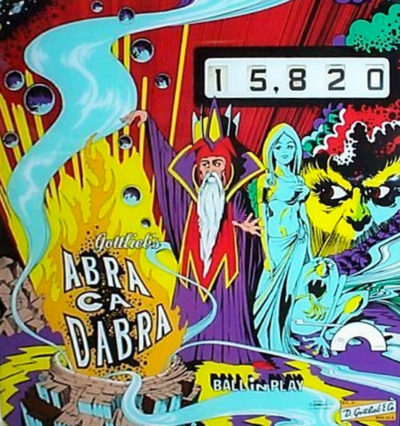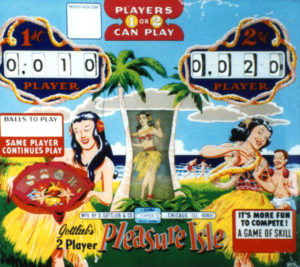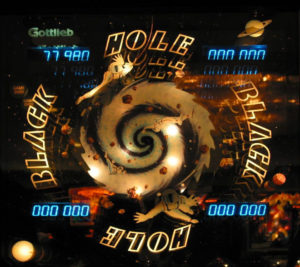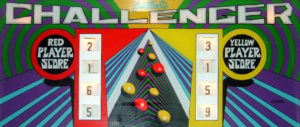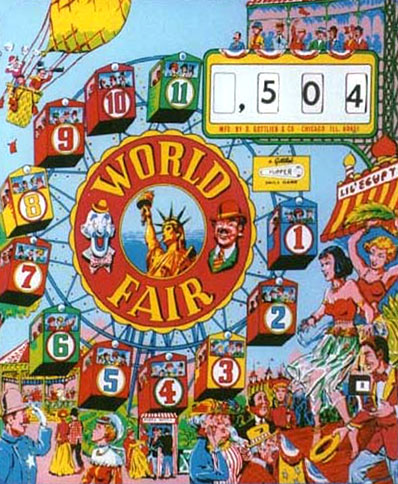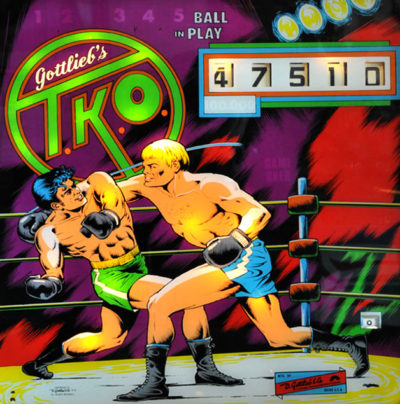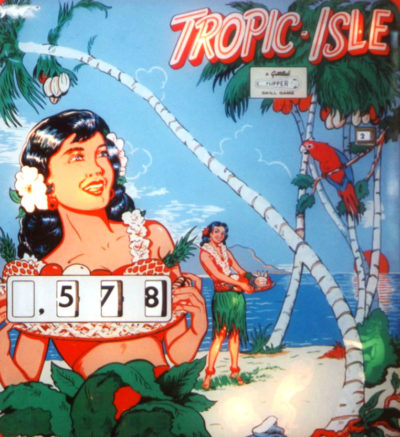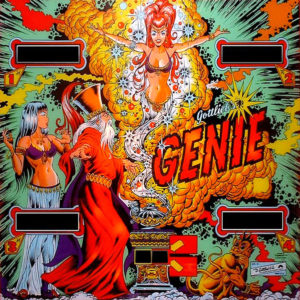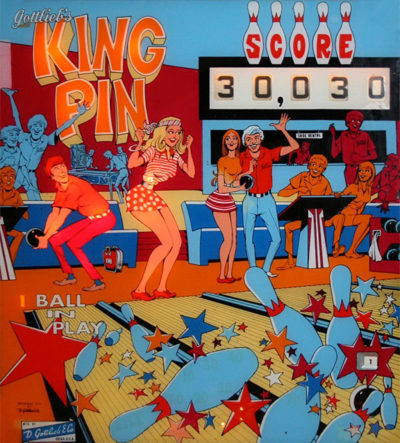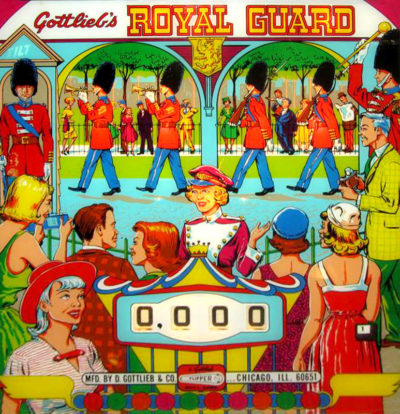-
This game is a classic and is rated # 5 in collectible machines of the ‘60s. The game was created by Wayne Neyens with artwork by Roy Parker. Production run was 2,875 units. The main action in the game comes from the four in-line kickout holes set across the center playfield. The object of the machine is to hit a suit of four cards vertically under the kickout holes. If you get all four, a hole will randomly light up to score a free game (i.e., a special). The challenge here is to sink the ball in the kickout holes once a special is lit. All four holes can light up if you’re lucky enough to score all 16 cards. Finally, another special in the top rollover lanes randomly lights if you score just the four top cards on the pattern of cards. Score also was a factor as dropping balls in the kickout holes with many cards lit scored a lot of points very quickly.Here’s another example of a Gottlieb single-player mechanical game when all the other manufacturers during this period were developing solid-state computerized machines. Ed Krynski is the designer with Gordon Morison the artist of choice for this model, one of 1,530 machines made. The machine itself is a classic ’70s. Ten numbers is your goal here. You achieve these ten targets by hitting and rolling over the appropriate spots on the playfield. Hitting the spinner spots the numbered target the spinner stops on. If you’re lucky to complete the targets, the special lights up and advances through the ten numbers. Hitting the lighted number with “special” lit means more free time playing the game. Score for replays is your second goal. Nice artwork in a single player game, one of the last produced.Gottlieb Pop-A-Card was another classic ‘70s playfield designed by Ed Krynski with artwork by Gordon Morison. Only 825 of these units were made. The replay version of the game was called Drop–A-Card which, as usual, was a much higher produced machine. The open playfield of this game gives ample room for scoring the three banks of drop targets. To win free balls with this game, you have to either complete the 2, 3, 4, and 5 targets, or the 6, 7, 8, and 9 targets…or the 10, J, Q, K, and Ace targets. The first two options light the wow feature to award free balls during that ball in play. If you hit the 10 thru Ace targets to completion, four rollovers light up to score extra balls. Of course, score is another way to score more balls.The last game of ’65 is a two-player add-a-ball game. It was designed by Ed Krynski with art by Roy Parker. A replay model also exists by the name of Paradise. Production run was a meager 265 units; the replay game had 2,100 units fabricated. The animated backglass on this game contains a dancing hula girl. When extra balls are won, they are represented as beach balls on the backglass. If you complete the sequence A, B, C, and D in that order, a free ball is your reward. Roto lights advance and indicate the value of the kickout holes. Points set by the operator award free balls also. An interesting guide rail is on either side of the flipper drains, a variation on a theme. This game is very rare due to its low production numbers.This rare add-a-ball game was released in April. It was designed by John Osbourne with artwork by Gordon Morison. A minimal total of 270 units were soldered together at the time. This is a small number for a pinball run. The replay version had a much larger production and the name of that game was Hit The Deck. As you can see from the backglass, Gottlieb tried to experiment with a score reel that was completely different in coloring. This was to attract attention to the game and attract quarters. The object of the game is to roll over the red number and/or black number sequence inherent in the game. If you are skillful enough to get the 9 to Ace sequence, some wow options will light up to score extra balls. A kickback feature is incorporated into the game in the upper-left area. This single-player game is challenging and a rare sight to see.Here is one you do not see every day. This is a Gottlieb Challenger from 1971. Only 110 of these were produced back in the day. How many are still around now … head-to-head pinball game with two players at opposite ends of the playfield, simultaneous soccer like play, can not be played with one player. Each player has flipper buttons which control only those flippers facing the opponent. Ball enters play from between the flippers. Game has 8 flippers and vertically mounted score reels. The playfield actually tilts towards and away from the players, depending on which end served the ball.The game before you is extremely rare with only 278 screwed together at the Chicago Gottlieb factory. This one-player electromechanical add-a-ball game was designed by John Osbourne with art by Gordon Morison. A replay version was also designed by the name of Blue Note. The object of this machine is to complete all the notes down the left side of the playfield. Doing so activates the classic “wow” feature which, when hit, awards one free ball. A reset is in your future once your current ball drains. Score is another way to achieve longer play by winning extra balls. The spinner in the middle of the playfield awards big points when 1,000 points is lit; each spin of the target awards 1,000 points plus number of revolutions spun. A nice retro art package completes this rare machine.This classic game is currently rated as the number two game of its generation. 4,650 units were produced in April of the year with design credits going to Roy Parker for artwork and Wayne Neyens for design. The game was produced to coincide with the New York World’s Fair of 1964-1965. The 11 ferris wheel cars depicted on the backglass are represented on the play field by roll overs and targets. Hitting a numbered car lights the corresponding backglass car. The interesting gadget developed for this game is the center spinning disc (i.e. ferris wheel) in the middle of the game. By spinning the disc, one randomly spots a ferris wheel car on the backglass. Completing all the cars awards a replay and the randomly advancing lighting of a rollover which, if you’re skilled enough, would award a replay if hit. Score is another way to conquer the machine. Enjoy trying your hand at this classic machine.May was the release month for this game. Designer Ed Krynski and artist Gordon Morison put together the package. Production run was low, at 675 units. This is an add-a-ball game variant, the replay version was called High Hand. The challenging part of this playfield design is trying to lock a ball in the eject hole for extra balls. Four batteries of drop targets in four colors are along the sides of the playfield. Making a completion of a color of drop targets increases the value of the eject and side drains. If all the drop targets are completed, the extra ball features light up. Score is another way to win balls set by the operator. No match units were incorporated into these games as, again, that was considered a form of gambling, i.e. winning a free game.This game was an “add-a-ball” game; the replay version was called 2001. Production run was 490 units. This was the first game to feature the in-line drop targets in a bank of targets. It was designed by Ed Krynski with art by Gordon Morison. A total of 20 drop targets divided into 5 targets per color. Knocking down a full left set of targets or a right set of targets awarded extra balls to be played during your current game (versus free games as the replay version awarded). The targets would reset after each ball. Extra balls were also awarded if certain scores were achieved as set by the operator. Previous high scores could be posted by the arcade on the backglass as a contest to try and beat the high score. This game was near the end of single-player Gottieb games with the smaller flippers. All in all, a classic game requiring accuracy in your shots to gain extra balls!Look no further! If you’re searching for the rarest of the rare, here for your perusal is not one but two examples of this Gottlieb aberration. Supposedly only 125 were made of this game and most were sold overseas. Ed Krynski and Gordon Morison again teamed up to art and design the game. This game represents one of the last electromechanical “wedgehead” games ever built near the shores of Lake Michigan. It’s also a single-player game and one of the last. The object of the game is not really boxing in the true sense but hitting enough targets to advance the central advance display up to the top of the rack. This will ignite the special lights for a free game. The color-coordinated advance inserts on the play field correspond to the light-up features on the play field and, if you advance the light sequence accordingly, those features light up for the brief time the advance mechanism stays on that light. Score is the easiest way to win a replay.Wayne Neyens designed this classic with Roy Parker penning the artwork. 2,700 of these were fabricated. This game has a holdover feature, which holds the monkeys’ positioning on the backglass from game to game. If you’re skillful enough to hit the A, B, C, and D targets, a monkey is advanced up the tree on the backglass. If one monkey makes it to the top, one replay is awarded: two monkeys score two replays, and three monkeys score three replays. Obviously if you pass this game and notice the third monkey nearing the top, feeding the coin slot was a natural for your just reward. Rolling over the 1 – 5 rollovers at the top of the playfield lights the side specials and awards 200 points once you drain the ball. A nice, well balanced game and quite a challenge not to lose your ball in play.Here’s another classic single-player wedgehead. This machine was designed by Jeff Brenner with art scrolled by Gordon Morison. 3,100 units came to fruition as well as an add-a-ball called Royal Pair. This open playfield design allows for a lot of action mandated by flipper shots all the way up the playfield. The object of the game is simple…by completing all the card targets and rollovers, three specials light. Hitting the ace target up top or scoring a lit rollover awards a replay. Another unique feature built into this machine is the random rollover values one may capture. 10, 100 or 1,000 points may be scored by rolling over one of four rollover targets when lit. The shots to the targets must be precise to score from the flipper. The outlanes are unique in design as they are angled. A very interesting variation of a Gottlieb card theme machine.This wide-body solid-state game was a high-production model with 6,800 units produced. The artwork was Gordon Morison’s creation with Ed Krynski penning the playfield. This pre-vocal machine is jam-packed with features. A mini playfield in the upper left consists of drop targets which, when completed correctly, light extra ball and special targets on the main playfield. Hitting a, b, c, and d on the top rollovers lights an extra ball feature on the mini playfield. Hitting the yellow star drop targets advances the multiplier bonus up to a 5x level. Interesting side drain configurations as well as the potential to score the kick-out hole playfield bonus prior to draining a ball is interesting. Five flippers grace the game. All in all, a great package and interesting flow for an early wide-body creation.This Gottlieb game is one of the five in the museum of the “flipper” series from Gottlieb. These games are all add-a-ball games. The layout of this game parallels a future Gottlieb classic by the name of “Buckaroo” (also in the museum). 1,550 of these machines were manufactured. Wayne Neyens designed the game and Roy Parker established the art package. Fifteen targets on the roto-target are present and spinning the roto would bring up new numbers to complete. If you are skillful enough to sequence four numbers in a row, an extra ball is awarded. The bull’s-eye target awards an extra ball also. Each time an extra ball is awarded, the backglass animation activates. The cowboy shoots at the targets, which causes them to spin. No match feature here and tilting the game forfeits the ball in play as well as a future ball in play.This game by Gottlieb is a very challenging design. It was invented by Ed Krynski and artwork was drawn by Gordon Morrison. This game has 10 drop targets lined up the left side of the playfield. If one target is hit, one scores 500 points. If, however, you’re skillful enough to hit a blue and white target at the same time, 5,000 points are awarded. Completing the sequence 1-9 lights the special at the bottom left rollover as well as lights the drop targets to score a special if all the targets are dropped. The player had to be wary when trying to freeze the ball on the right flipper, as one could lose the ball up the right guide rail (which has an opening in it the size of a ball). This playfield design was used a few times by Gottlieb, as it was a successful design (games like Gottlieb 300, for example, a bowling themed game). Scoring games by core were another option.September was the month for the introduction of this game. Both solid-state and mechanical versions were produced (9,950 versus 550 units, respectively). Ed Krynski designed the machine with art by Gordon Morison. A roto-target was incorporated into the upper right of the game, a Gottlieb exclusive. Hitting the A-B-C rollovers lights up the extra ball target and increases the value of the roto-targets as well as the drop target values. Knocking down all the drop targets increases the bonus multiplier value. The second time this feat is completed lights the special roto-target value. This game also features a bonus advance bank which increases to 20,000 points and a two to five times bonus multiplier feature. Score is the other way to win games.
-
This game is a classic and is rated # 5 in collectible machines of the ‘60s. The game was created by Wayne Neyens with artwork by Roy Parker. Production run was 2,875 units. The main action in the game comes from the four in-line kickout holes set across the center playfield. The object of the machine is to hit a suit of four cards vertically under the kickout holes. If you get all four, a hole will randomly light up to score a free game (i.e., a special). The challenge here is to sink the ball in the kickout holes once a special is lit. All four holes can light up if you’re lucky enough to score all 16 cards. Finally, another special in the top rollover lanes randomly lights if you score just the four top cards on the pattern of cards. Score also was a factor as dropping balls in the kickout holes with many cards lit scored a lot of points very quickly.





